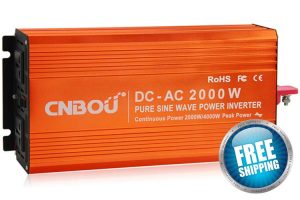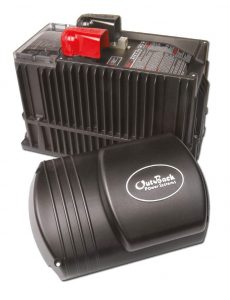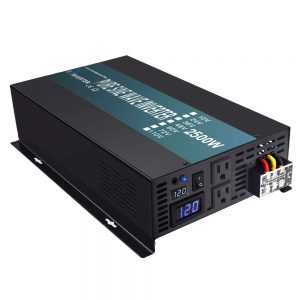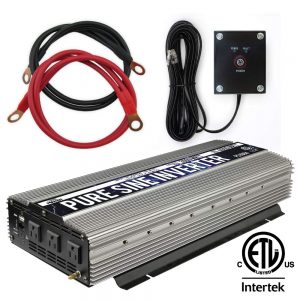Inverters will convert your battery power to Alternating Current (AC) power. This will let you run everything from your laptop to your hair dryer. Having a good inverter that’s always on can make your RV feel a lot more like living in a house instead of a “camping” experience.
There’s a few major factors to consider when buying an inverter.
Watts
What kinds of items are you trying to power? If you’re only trying to charge your laptop and some camera gear, a very small inverter (say, 300 watts or so) will do fine. If you’re looking at running a fridge or a large TV, I’d recommend at least a 1,000 watt inverter. For most people that want to be able to run a microwave, induction cooktop, instant pot, blender, toaster oven, and even the air conditioning on occasion, a 2,000 watt inverter is required. Of course, you can only run one of those major appliances at a time.
If you want the ability to run multiple large appliances at the same time, you’ll need a very large inverter. I plan on roughly 1,500 watts per large appliance, when it’s running. 3,000+ watt inverters are common for running these large loads.
I personally have a 3,600 watt inverter which can push 4,000 watts for up to 30 minutes. When we’re cooking with two induction units and a toaster oven all at the same time (which happens frequently), I’m always very impressed with my inverter. You do, of course, need a battery bank that can keep up with that kind of load, and that’s another discussion entirely.
Modified Sine vs Pure Sine
Just get a Pure Sine Inverter. Don’t mess around with Modified Sine.
Why is modified sine even an option? It’s cheaper. I can’t recommend it and will never advise people to try to save a few bucks here. It’s hard on your electronics and it’s not as safe as pure sine. There isn’t that much of a cost savings, and there’s no real reason to fool around with it. Just get a pure sine inverter.
Standby Power
If you’re planning on leaving your inverter on all the time, this becomes a factor to consider. If you’re only enabling your inverter when needed, then it really isn’t a concern. The higher the standby power number is, the more power you’re using just to keep the inverter running. This is often the reason most RVers turn off their inverters when they’re not being used.
Hard-wire vs Receptacle Connectors
Some inverters come with a plug or two right on the unit. Super convenient for hooking stuff up! Others though have only the wired connections on them, requiring you to do the wiring yourself to a circuit breaker or individual outlets.
The units that have regular household-looking receptacles on them are meant for light use and convenience in switching things around. They’re not designed for running a whole-house system on a permanent installation. Sure, you can buy an extension cord and hack it apart and get at the wires necessary to connect it to a circuit breaker, but that’s not what it was designed for. It’s meant for someone that has pretty minimal needs that isn’t doing a whole-house conversion.
The units that have wired-only connectors are mean to be connected to a circuit breaker. These are best for whole-house conversions as they’re designed for that purpose. Generally higher-powered inverters have these kinds of connections.
Inverter-Charger
Many higher-end inverters also have the ability to charge batteries. This can be convenient because when you plug into shore power, they can switch off their inverter functionality and automatically convert to being a battery charger. Most of these types of inverters have programmable options and so can be used with Lithium batteries as well.
Hybrid Inverter
Hybrid inverters allow you to take some power from the grid or generator and supplement it with battery power when needed. This is a fantastic feature that I highly recommend for anyone that is getting a high-power inverter.
Let’s say you have a 3,600-watt inverter. That’s the same amount of power you’d have if you were plugged into an RV park with a 30-amp hookup. You’re probably going to be running everything in your rig on electric, including air conditioning. When the sun is shining, you’re in great shape.
But then it gets cloudy for a day or two, and your battery bank starts running low. You’ve got a Honda 2000, or maybe you can run an extension cord to your friends house ’cause you’re moochdocking. Either way, those sources aren’t going to give you a 30-amp hookup. But with a hybrid inverter, it’s no problem!
Simply tell the inverter how much power to draw from the generator or shore power source, and the system will intelligently only draw that much power and take what it needs from the batteries when the demand is higher. Most of the time you’re not using a full 30 amps of AC power. So if you setup your inverter to only draw 10 amps, it’ll draw those 10 amps and provide power to either your AC appliances, or if they’re not drawing that much, it’ll use that power to charge the batteries. Really awesome way you can use a little generator and still power a massive rig.
BESTEK 300
Input Power: Cigarette Lighter
Output Power: Receptacle
Watts: 300
Link: Amazon
This connects via a cigarette lighter port, which is generally fused at 15amps. On a 12-volt system, that’s only 180 watts. Given a converter efficiency of about 85%, that mean you can only push 153 watts continuously, in the best-case situation. Basically, don’t expect to get a full 300 watts out of this inverter unless you hard-wire it to a battery (remember to fuse it!), and even then, it’s meant for light use.
Giandel 1200
Input Power: Hard-Wired
Output Power: Receptacle
Watts: 1200
Link: Amazon
This is a good option for situations where light power needs are required. Laptops, TVs, smaller blenders, mini-fridges, and other small appliances would work well with this inverter.
CNBOU
Input Power: Hard-Wired
Output Power: Receptacle
Watts: 2000
Link: Continuous Resources
The key benefit to this inverter is US-based support. Should anything ever go wrong, you can call a real human and talk to them using the English language. Real bonus!
A remote is available as well, and it can be configured for various input voltages too, which is handy.
Samlex
Input Power: Hard-Wired
Output Power: Receptacle & Hard-Wired
Watts: 2000
Link: Amazon
This is a highly-rated inverter that is rated as “commercial grade”. Based on multiple review sources, this appears to be a solid unit, and it costs a bit more than most of the other inverters listed here. A remote is available separately to make it easy to turn on or off. Also available in 300, 600, and 1500 watt versions.
Outback
Input Power: Hard-Wired
Output Power: Hard-Wired
Watts: 2000
Link: Amazon
Outback inverters come with a 5-year warranty. That’s the best I’ve ever seen, and there’s a reason for it: quality product. I’ve been running a large outback inverter under every kind of condition possible for over a year now and it’s been 100% reliable, no issues of any kind. They are the most expensive inverters, but if you want a solid and reliable product, this is it.
Giandel 2200
Input Power: Hard-Wired
Output Power: Receptacle
Watts: 2200
Link: Amazon
Basic inverter, has good reviews on Amazon, even includes a very basic solar charge controller.
WZRELB
Input Power: Hard-Wired
Output Power: Hard-Wired
Watts: 2500
Link: Amazon
A less expensive 2000-watt class inverter with line level outputs is a nice option. This inverter does not have a remote though, so it’s best suited to those that leave their inverter on 24/7 or have easy access to the inverter itself to turn it on and off when needed.
GoWISE
Input Power: Hard-Wired
Output Power: Receptacle
Watts: 3000
Link: Amazon
This is a less-expensive inverter with mostly-good reviews. It does not have hard-wired outputs, which is surprising for a unit of this rated wattage. Given its price, this seems like a good inverter for those with 2,000 watt needs since it may not withstand its actual rated capacity.
Magnum Energy MSH3012M Inverter/Charger
Input Power: Hard-Wired
Output Power: Hard-Wired
Watts: 3000
Charger: Included
Hybrid: Yes
Link: Amazon, Magnum
This is a popular inverter in the RV community that has it all. Pure sine wave, remote control panel, hybrid input, battery charger. Easy whole-house inverter to recommend. Available in 12 and 24 volt input configurations.
Victron Multi-Plus
Input Power: Hard-Wired
Output Power: Hard-Wired
Watts: 1600 or 2400
Charger: Included
Hybrid: Yes
Link: Amazon, Victron
Victron units are also popular. Interesting, in their data sheets, the “2000” unit can do 2000VA, but not a full 2000 watts, even at ideal temperatures. Same for the 3000 watt unit. Victron is well known for reliability and is considered a market leader.
Giandel 4000
Input Power: Hard-Wired
Output Power: Receptacle & Hard-Wired
Watts: 4000
Link: Amazon
If you need a beast of an inverter, they’re available. At this power rating, I highly suggest using a 24v (or better) battery bank.












